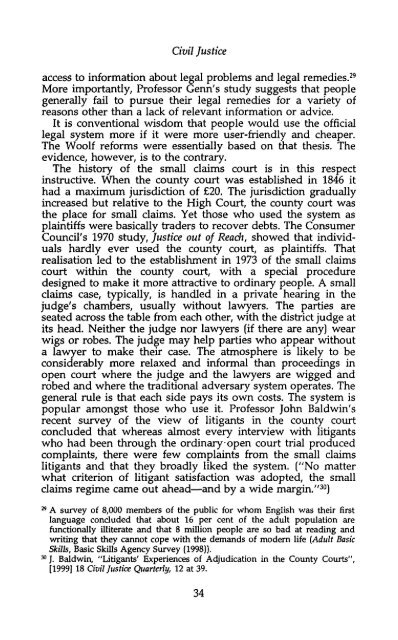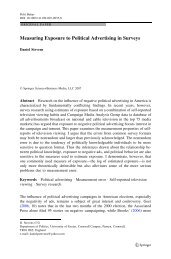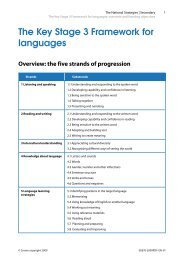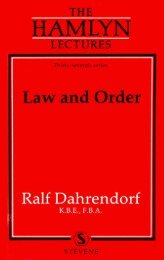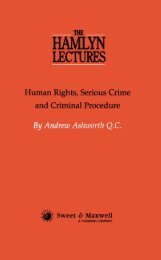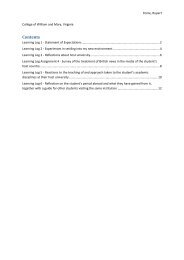HAMLYN - College of Social Sciences and International Studies ...
HAMLYN - College of Social Sciences and International Studies ...
HAMLYN - College of Social Sciences and International Studies ...
Create successful ePaper yourself
Turn your PDF publications into a flip-book with our unique Google optimized e-Paper software.
Civil Justice<br />
access to information about legal problems <strong>and</strong> legal remedies. 29<br />
More importantly, Pr<strong>of</strong>essor Germ's study suggests that people<br />
generally fail to pursue their legal remedies for a variety <strong>of</strong><br />
reasons other than a lack <strong>of</strong> relevant information or advice.<br />
It is conventional wisdom that people would use the <strong>of</strong>ficial<br />
legal system more if it were more user-friendly <strong>and</strong> cheaper.<br />
The Woolf reforms were essentially based on that thesis. The<br />
evidence, however, is to the contrary.<br />
The history <strong>of</strong> the small claims court is in this respect<br />
instructive. When the county court was established in 1846 it<br />
had a maximum jurisdiction <strong>of</strong> £20. The jurisdiction gradually<br />
increased but relative to the High Court, the county court was<br />
the place for small claims. Yet those who used the system as<br />
plaintiffs were basically traders to recover debts. The Consumer<br />
Council's 1970 study, Justice out <strong>of</strong> Reach, showed that individuals<br />
hardly ever used the county court, as plaintiffs. That<br />
realisation led to the establishment in 1973 <strong>of</strong> the small claims<br />
court within the county court, with a special procedure<br />
designed to make it more attractive to ordinary people. A small<br />
claims case, typically, is h<strong>and</strong>led in a private hearing in the<br />
judge's chambers, usually without lawyers. The parties are<br />
seated across the table from each other, with the district judge at<br />
its head. Neither the judge nor lawyers (if there are any) wear<br />
wigs or robes. The judge may help parties who appear without<br />
a lawyer to make their case. The atmosphere is likely to be<br />
considerably more relaxed <strong>and</strong> informal than proceedings in<br />
open court where the judge <strong>and</strong> the lawyers are wigged <strong>and</strong><br />
robed <strong>and</strong> where the traditional adversary system operates. The<br />
general rule is that each side pays its own costs. The system is<br />
popular amongst those who use it. Pr<strong>of</strong>essor John Baldwin's<br />
recent survey <strong>of</strong> the view <strong>of</strong> litigants in the county court<br />
concluded that whereas almost every interview with litigants<br />
who had been through the ordinary-open court trial produced<br />
complaints, there were few complaints from the small claims<br />
litigants <strong>and</strong> that they broadly liked the system. ("No matter<br />
what criterion <strong>of</strong> litigant satisfaction was adopted, the small<br />
claims regime came out ahead—<strong>and</strong> by a wide margin." 30 )<br />
29 A survey <strong>of</strong> 8,000 members <strong>of</strong> the public for whom English was their first<br />
language concluded that about 16 per cent <strong>of</strong> the adult population are<br />
functionally illiterate <strong>and</strong> that 8 million people are so bad at reading <strong>and</strong><br />
writing that they cannot cope with the dem<strong>and</strong>s <strong>of</strong> modern life [Adult Basic<br />
Skills, Basic Skills Agency Survey (1998)).<br />
30 J. Baldwin, "Litigants' Experiences <strong>of</strong> Adjudication in the County Courts",<br />
[1999] 18 Civil Justice Quarterly, 12 at 39.<br />
34


